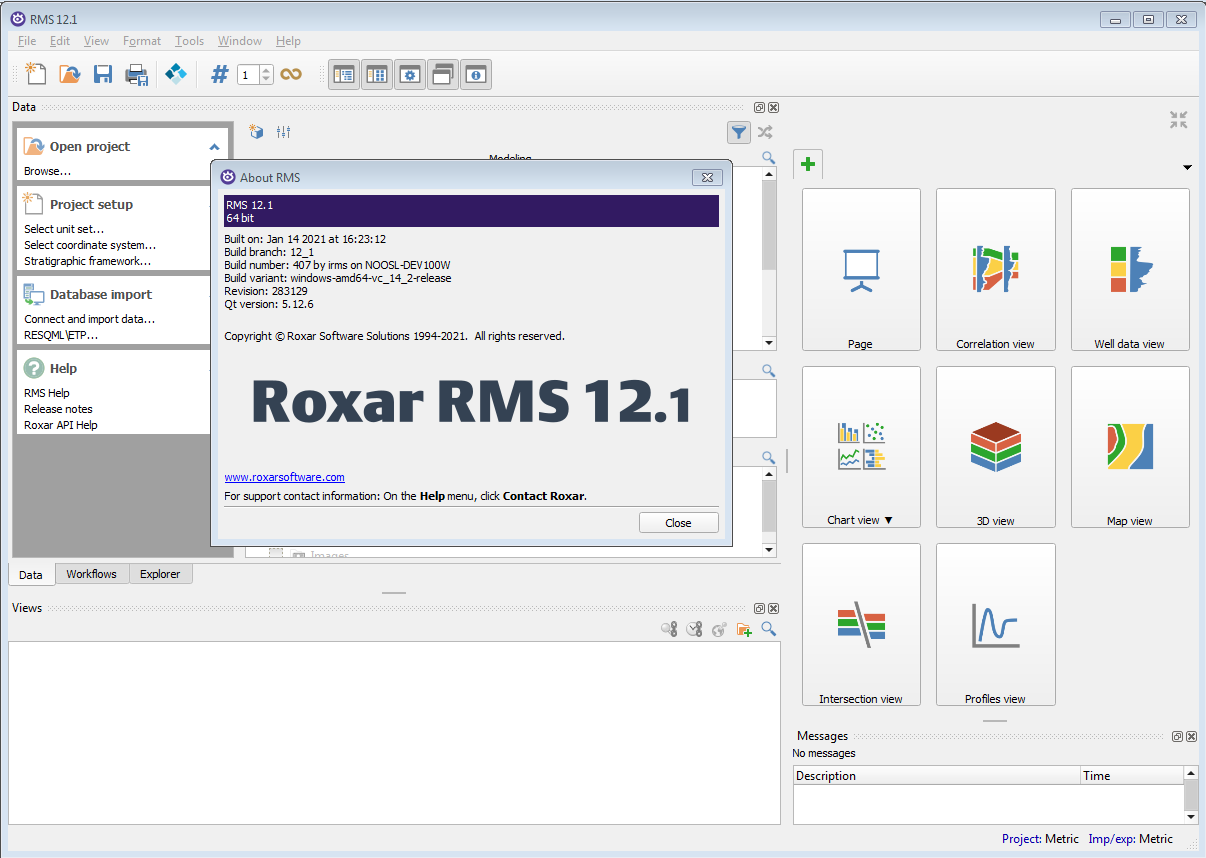ساخت مدل زمین شناسی | ROXAR RMS 12.1

A complex giant field always poses substantial reservoir management challenges, and such fields are often associated with low recovery factors, despite good reservoir quality. The RMS™ 3D modeling software is an industry-leading geoscience and reservoir engineering collaboration platform, offering geophysicists, geologists and reservoir engineers a shared space to compile, visualize and manage a wide range of subsurface data for fields of any size and complexity. The software enables users to integrate information coming from multiple sources, perform interpretations, and build reservoir models for which uncertainties on both data and interpretations can be captured and propagated across the workflow.

RMS 12.1 (2021 version)
Smart, interactive reservoir modeling for superior results in less time
A complex giant field always poses substantial reservoir management challenges, and such fields are often associated with low recovery factors, despite good reservoir quality. The RMS™ 3D modeling software is an industry-leading geoscience and reservoir engineering collaboration platform, offering geophysicists, geologists and reservoir engineers a shared space to compile, visualize and manage a wide range of subsurface data for fields of any size and complexity. The software enables users to integrate information coming from multiple sources, perform interpretations, and build reservoir models for which uncertainties on both data and interpretations can be captured and propagated across the workflow.
Best-in-class stochastic facies object modeling in RMS.
RMS provides an integrated interdisciplinary perspective to properly manage and optimize the reservoir’s potential, with the ability to leverage the seismic data and accommodate complex geologies. The result is faster, more robust and more reliable production models, improved decision-making, more justifiable investments, and enhanced field performance, leading to higher recovery rates in even complex reservoirs.
The heart of RMS is the workflow manager, which enables workflow automation and is connected to the uncertainty management module. Workflow automation allows fast update of models and the easy generation and analysis of scenarios and sensitivities. RMS workflows can be run on your desktop or in clusters running hundreds of workflows in parallel. The workflow and modeling capabilities of RMS are cornerstones for the Emerson Big Loop™ offering, along with the Tempest™ reservoir engineering software suite.
Data visualization and analysis are an integral part of RMS, where 3D visualization, 2D map views, cross sections, well sections, and a host of charts can work together to give users insight into their data and models.
RMS can be extended through the use of Python-based API’s that are integrated with the workflow manager and uncertainty management. The wide range of Python libraries available make this a very powerful solution. With RMS Plugins, users can create interfaces and visualization using JavaScript HTML5.
For many years, RMS has been used by its customers to build highly detailed reservoir models that support reliable decision making. These help companies maximize the recovery factor, reduce time to first oil, and stabilize production in even the most complex scenarios.
RMS Benefits
RMS adds value throughout the reservoir life cycle.
Propagates knowledge to decision makers in a single, integrated application.
Delivers reliable and accurate reservoir models that increase return on investment in the reservoir.
Accelerates field development through more collaboration and a deeper analysis of the model.
Quantifies geological risk across the entire value chain, for faster, better decision-making.
Optimizes your team’s experience and knowledge.
RMS Features
Strong technical capabilities for all kinds of plays, including complex structural geometries
Unique structure uncertainty workflow for improved 3D models and uncertainty handling
Super model handling capacity (high-performance gridder)
Multi-platform (Linux and Windows)
Flexible workflow manager, focused on automated, updatable and reproducible processes
Best-in-class modeling technology
Cost-efficient development and integration of customized solutions using Roxar API
Using RMS Plugins, create interfaces and visualization using JavaScript HTML5
RMS Modules
FACIES MODELING
The facies modeling modules offers a range of methods for modeling geological facies, enabling the characterization of all geological environments. Both object-based and pixel-based facies modeling are avilable.
FAULT SEAL ANALYSIS
RMS Fault Seal Analysis allows geologists and reservoir engineers to quickly and easily analyze sealing effects occurring in fault regions. Data representing the degree of sealing can be generated and used as a basis for seal analysis or as input to a flow simulator. Uncertainty in fault sealing effects is properly handled and can be integrated into overall workflows. Characterization of sealing effects can significantly improve the quality and speed of a simulation history match.
FRACTURE MODELING
The RMS Fracture Modeling technology helps both general and specialist users gain insight into their reservoir behavior. RMS Fracture is both fast and easy enough for fracture model creation and updating to become as routine as updating the facies model. RMS focuses on efficiently building effective fracture models based on:
Conditioning models to well fracture data.
Providing geologically reasonable extrapolation trends for well data.
Using dynamic information to constrain the model based on interpreted well test permeability.
GEOLOGICAL INTERPRETATION
The close integration of geological interpretation and geological modeling delivers a very strong solution. Managing zones and well picks while creating maps makes the workflow both fast and efficient. Powerful integration between managing well fences in map views and cross sections and well sections views makes visualization powerful. Quality control is enhanced through powerful log operations for extracting mis-tie data, to make all kinds of well average data per well per zone using logs, blocked wells or 3D grid data.
MAPPING
RMS Mapping combines advanced mapping and industry-standard algorithms, to allow allows users to map geological horizons in depth or time. Time horizons and fault data can be converted from time to depth using a 3D velocity model. The velocity model is built using a variety of user-defined functions. Integration with other RMS modules makes results easily available throughout the workflow.
MODEL-DRIVEN INTERPRETATION
RMS model-driven interpretation (MDI™) combines the strong structural modeling in RMS with a patented snapping functionality, enabling seismic horizons to be snapped to seismic features. The user adds interpretation points where needed and lets the snapping algorithms follow the seismic features automatically.
In RMS, interpreters and modelers can capture interpretation uncertainty in depth or time directly while creating their interpretation. This uncertainty data can be carried through the full structural modeling workflow to aid statistical analysis of reservoir properties.
PROPERTY MODELING
RMS offers a full suite of petrophysical modeling tools, from 2D interpolation to 3D stochastic modeling, conditioned to wells, facies and seismic data. Models can be updated globally or locally as new data is acquired, keeping the models accurate and the decisions focused.
SEISMIC INVERSION
RMS seismic inversion allows geoscientists to use seismic data to quickly create a rock property model. Moreover, it provides an accurate result with the implementation of highly efficient geostatistical algorithms: fine scale information from well logs is combined with band-limited information from the seismic data to provide an inversion where the output elastic parameters have realistic behavior.
SIMULATION MODEL BUILDING AND FLOW SIMULATION
Creating input to dynamic flow simulators is often a complex process. RMS has workflows that enable the creation of datasets for various dynamic flow simulators. All of the functionality can run in the workflows, automating the process and allowing geological modeling workflows and dynamic simulation to be run back to back. This is a critical component in the Big Loop solution.
STREAMLINE ANALYSIS
Streamline simulations can be used for dynamic analysis of the reservoir, for validation and ranking of reservoir modeling scenarios, and for quality control of property upscaling. Due to its fast algorithms, RMS streamline simulations work for large models where conventional simulation methods struggle to deal with the large number of grid cells. Dynamic simulations can be performed with both geo models and flow models.
STRUCTURAL MODELING
RMS structure modeling solution provides tools and workflows for going from data to grid in a minimum number of steps without compromising the structural integrity of the model. The integrated system helps users achieve maximum reservoir performance and better decisions through quick and accurate characterization of their reservoirs.
STRUCTURAL UNCERTAINTY MODELING
RMS structural uncertainty modeling tools are designed to help the decision maker acknowledge and quantify the uncertainties associated with the modeling of a structural framework. Sensitivity studies of key parameters, such as horizon depths and fault locations, are facilitated through a transparent, powerful, and fully reproducible way of modeling. Fault and horizon uncertainty tools tightly linked to structure modeling and 3D gridding make it fast and easy to build several geological scenarios for investigating the effect of structure uncertainty.
UNCERTAINTY MANAGEMENT
RMS supports more reliable decision-making through the consistent treatment of uncertainties throughout the workflow, not just limited to geological modeling. The range of parameter uncertainties includes: seismic interpretation, structure, velocity model, facies, net to gross, porosity/permeability, water saturation, fluid contacts and development scenarios. The manager is very easy to use, with a clean, clear graphical interface supported by tremendous power.
Linked to other Emerson solutions, it provides the most comprehensive and sophisticated workflow in the industry – Big Loop.
WELL PLANNING AND GEOSTEERING
Planning wells and testing different well concepts, running sensitivities, and optimizing wells are an essential part of reservoir management. With RMS well planning, it is easy to digitize new well trajectories and constrain trajectory geometries using real drilling constraints. For verification, optimization of the planned well using your dynamic simulator of choice, RMS offer workflows to add completions, perforations and export to your simulator format.
Geosteering and landing horizontal wells optimally in the reservoir can be challenging. The integrated real time data reader and geosteering capability in RMS provides techniques to visualize and calculate how far into the stratigraphy the bit is; this information, together with knowledge about the target location, provides essential information to directional drillers about how to land and steer the well optimally.
ROXAR API
Roxar™ API is a platform for customization and knowledge sharing. It enhances efficiency and reduces cost through the automation of repeatable workflows. It helps solve data management challenges by preserving vital information across internal and third-party formats, and provides innovative ways to explore new methodologies for visualization and analysis.
Roxar API builds bridges between different applications and extends the capability of internal products by providing an easy-to-use approach to script creation, plugins and standalone applications using the Python language. With API, users can retrieve data, make a copy of data and store it into another data object, run calculations against data, create new data items, save projects as a new name, and much more.
RMS SUPPORTS GEOPHYSICISTS, GEOLOGISTS AND RESERVOIR ENGINEERS, ENHANCING DATA INTEGRATION AND CROSS-DOMAIN COLLABORATION
A seamless workflow, from seismic to flow simulation
A seamless, automated and easily repeatable workflow, from seismic to flow simulation to efficiently maintain evergreen 3D models.
Geophysics
Capture uncertainties, generate multiple realizations and build accurate and robust reservoir models.
Model Driven Interpretation (MDI)
Velocity Modeling
Model Update
Multi Realization
Geology
Accelerate the field development planning cycle and drilling programs by allowing multiple disciplines to work simultaneously on a common reservoir model.
Data Analysis
Structural Modeling
Structural Uncertainty / Uncertainty Modeling
Property Modeling
Well Planning and Geosteering
Reservoir Engineering
Support an economic decision-making process, and have full confidence in your reservoir management with fast and accurate simulation results.
Gridding and Upscaling
Fault Seal Analysis
Simulation (streamlines, flow simulation)
Interoperability with Tempest™
Data Integration and Cross-Domain Collaboration
Get a complete overview of the available data centralized in one shared platform, and break down the operational/domain silos.
RESQMLData Transfer
Data Management (data explorer)
Well Correlation
QC Tools
Data Analysis
Visualization
Dynamic Data Handling
RMS Modules
RMS Facies Modeling
RMS Mapping
RMS Structural Modeling
RMS Fault Seal Analysis
RMS Model-driven Interpretation
RMS Structual Uncertainty Modeling
RMS Flow Simulation
RMS Property Modeling
RMS Uncertainty Management
RMS Fracture Modeling
RMS Seismic Inversion
RMS Well Planning
RMS Geological Interpretation
RMS Simulation Model Building
Roxar API
RMS Interoperability
RMS Streamline Analysis
تیم PetroTools آخرین نسخه این نرم افزار را برای شما ارائه می دهد. جهت تهیه نرم افزار با استفاده از منوی خرید با ما در تماس باشید
For buy software, Please contact us via buy menu



 O-Sense
O-Sense
